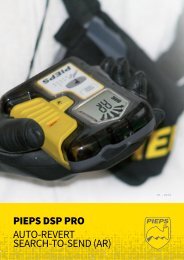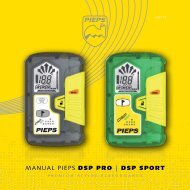LVS HintergrundwiSSen - pieps
LVS HintergrundwiSSen - pieps
LVS HintergrundwiSSen - pieps
Sie wollen auch ein ePaper? Erhöhen Sie die Reichweite Ihrer Titel.
YUMPU macht aus Druck-PDFs automatisch weboptimierte ePaper, die Google liebt.
5. INTERPRETION and CONCLUSIONS<br />
If all available test series from June 2007 until<br />
July 2008 are taken into account, the average<br />
time for pinpointing vs. probing with and without<br />
iProbe can be estimated!<br />
Figure 6:<br />
Time brake down<br />
for pinpointing vs.<br />
Probing, all test<br />
series from June<br />
2007 until July<br />
2008<br />
Pinpointing<br />
Probing<br />
Classic Probe 52 sec. 21 sec.<br />
Using iProbe<br />
Reduction<br />
21 sec.<br />
60%<br />
12 sec.<br />
43%<br />
Furthermore, if it is taken into account, that pinpointing and probing together was roughly 60% of the overall<br />
search time, a reduction of about 50% in pinpointing/probing will result in a reduction of 30% of the overall<br />
beacon search time!<br />
The following important conclusions can be achieved from this study:<br />
n Conclusions using avalanche safety gear with classic probes:<br />
If you take all field tests into account, a clearly shown coherency between time for pinpointing and time to<br />
get the confirmation with the probe is obvious. Using a classic probe, you have to be more accurate with your<br />
pinpointing (i.e. you have to invest more time) to reduce the time for probing. But there is still the problem of<br />
doubts about the probing result. In dependence with snow conditions, burial depth, gradient of the slope and<br />
skills of the test person up to 20% of the cases indicate a “found victim” without an actual target hit! During<br />
the final exams of the Austrian Mountain Guide education approx. 10% of the examinees failed there “final<br />
run” due to insufficient accuracy of pinpointing and timeout while probing. Especially doubts and uncertainness<br />
while probing have significant influence to the final time. While using a training station - equipped with<br />
a probe hit indication - a time period up to 6 minutes could have been identified, beginning from a target hit<br />
indication (given from the training station) until the final recognition from the test person.<br />
n Conclusions using avalanche safety gear with the iProbe:<br />
When using the iProbe, the time for pinpointing can be reduced by almost 50%. There is no need anymore<br />
for being too precisely. Time can be saved! In most cases the time for probing also can be reduced<br />
to the half. Doubts or uncertainness hasn’t been observed anymore.<br />
6. acknowledgments<br />
Thanks to all test persons, volunteers and education staff members<br />
helping us gathering detailed field test information.<br />
7. References<br />
Tschirky, F., Brabec, B. and Kern, M. 2000.<br />
Avalanche rescue systems in Switzerland:<br />
experience and limitations. Proceedings<br />
International Snow Science Workshop, Blue Sky<br />
MT, USA, 1-6 October 2000.<br />
Dominique Stumpert (2002; Frankreich)<br />
PREMIUM ALPINE PERFORMANCE 23





